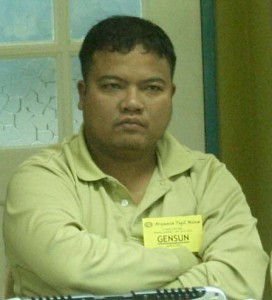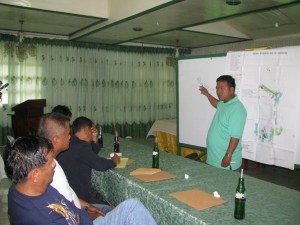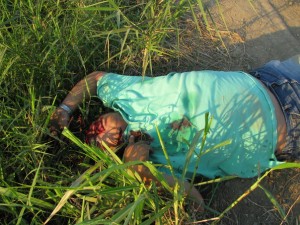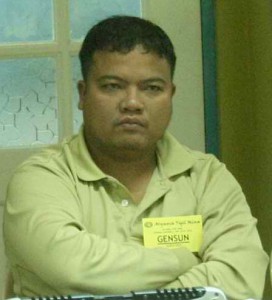 By FARAH SEVILLA and DENISE FONTANILLA
By FARAH SEVILLA and DENISE FONTANILLA
Alyansa Tigil Mina
(First of two parts)
THE SOCIAL networking site Facebook is the venue of a quiet protest that has been going on for a year now, where people are venting their concern over magnetite mining in Cagayan province.
A Facebook page named “Stop Black Sand Mining in Cagayan” has garnered some 3,700 supporters who have been using the online space to speak up not only against the environmental destruction magnetite mining brings, but also about the deaths it has caused.
In fact, the page was put up shortly after 30-year-old anti-mining advocate Gensun Agustin was gunned down by unidentified men in Buguey, Cagayan on March 1 last year while riding his motorcycle on his way home.
Agustin was one of five anti-mining activists killed within months of each other in that mining town on the country’s northernmost shore. All deaths remain unresolved.
The five had been actively campaigning against the extraction of magnetite, a black sand ore abundant in the province and commonly used as an additive for high-strength concrete and steel products.
Agustin was a founder of the Federation of Anti-Mining Advocates in Cagayan (FAMAC), composed of about 100 members from 10 towns in the province’s first congressional district. He also headed the Alliance of Buguey Community Development Advocates (Albucoda).
“Itinuturing ko na pong anak ‘yan dahil araw-araw po ay nagkikita kami (I consider him as my son because we used to meet every day),” said Evelyn Giron-Lacambra, the 56-year-old president of the Concerned Lal-loqueños against Illegal Mining (CLAIM) and FAMAC officer.
Lacambra said Agustin would go around carrying a map that showed exactly how many companies or “permittees” had been allowed to mine in the province. “Sa lahat pinapakita po niya. Siya po kasi ’yung pinakamatapang sa grupo (He shows it to everyone. He is the bravest of our group),” she added.
been allowed to mine in the province. “Sa lahat pinapakita po niya. Siya po kasi ’yung pinakamatapang sa grupo (He shows it to everyone. He is the bravest of our group),” she added.
Months earlier, on Nov. 30, 2009, brothers-in-law Pedrito Tabaco and Alfredo Rabit, who were Agustin’s co-members in FAMAC and Albucoda, were also riding a motorcycle on their way home when unidentified men shot and killed them.
On May 9, 2010, some two months after Agustin’s death, Conrado Buenaflor was shot in front of his house and died at the hospital four days later. Buenaflor was head of Task Force Lapu-Lapu and a member of the Citizen Action Unit, two organizations that monitor magnetite mining and illegal fishing activities.
Six days later, the barangay captain of Fula, William Arzadon, died on the spot from multiple gunshots in Buguey. He was riding his motorcycle on his way home.
Another anti-mining activist, Adamson Arellano, was shot in the leg and foot on May 17, also by still unidentified men, but he survived.
“These are not isolated, unrelated and coincidental cases,” said Judy Pasimio, executive director of the Legal Rights and Natural Resources Center, a policy and legal nongovernment organization working with marginalized communities directly dependent on natural resources.
“These are individuals whom we have known and worked with in the struggle against mining, and they have been killed one by one as the government continues to promote mining by opening up lands for mineral extraction and facilitating the entry of corporations,” she said.
Pasimio added that the national government has been supporting mining activities despite the opposition of communities, civil society and even local government units.
Lacambra said opposition to mining in Cagayan spread after residents started noticing the effects of mining on their livelihood and environment. The clams (cabibi) which they gather and sell to buy food have become scarce.
“Isang baso na lang maghapon, e dati sako-sako (They used to harvest sacks of clams, now get just one glass after a day’s work),” she said.

Studies have revealed that black sand mining in coastal areas has resulted in coastal erosion, inundation of communities and degradation of marine ecosystem, Clemente Bautista, Kalikasan People’s Network for the Environment (Kalikasan PNE) national coordinator, said in a statement.
A March 2008 report by the nongovernment organization Katinnulong Daguiti Umili iti Amianan Inc. (Kaduami) showed that magnetite mining in Cagayan increases the province’s vulnerability to floods.
Magnetite holds the sand together and its absence can cause erosion of coastal and near-shore areas. This further leads to the loss of farmlands and agricultural areas near coastal areas and of marine sources of food and livelihood.
Because of
the killing of anti-mining leaders, Lacambra said the people have become afraid to speak up, even when they see ships they know are loaded with magnetite.
“Basta tumitingin na lang po sila sa mga barko (na) dumadaan sa bahay nila. Wala silang sinasabi, wala silang reaksyon
, dahil natatakot po sila (They just stare at the boats that pass by their house. They don’t say anything, they don’t react, because they are scared),” she said.
In the “Stop Black Sand Mining in Cagayan” Facebook page, a user going by the name Esperlita Garcia wrote a response to an online news report in the Nueva Vizcaya-based Valley Journal, asking for help from the Church: “Very Reverend Fathers, please rescue us here. We are afraid to speak in the open but we are more afraid knowing that thousands of tons of black sand (are being) extracted in our town.”
She added that no protective wall has been built to prevent erosion and the massive destruction that can happen. Already, sea water has reached the infrastructure projects in the town, as well as the houses.
For her part, Lacambra is not backing down, frustrated though she may be with her neighbors and affected by the deaths of her colleagues. Only her middle child approves of her activism, she confided, while the rest of her family has urged her to stop.
“Inaalala ko lang ang kinabukasan ng mga apo ko. Dito lang ako naging masaya talaga. Lahat naman tayo mamamatay (I’m only thinking of the future of my grandchildren. It is only in doing this that I have felt happy. We will all die anyway,” she said.
(To be concluded)
